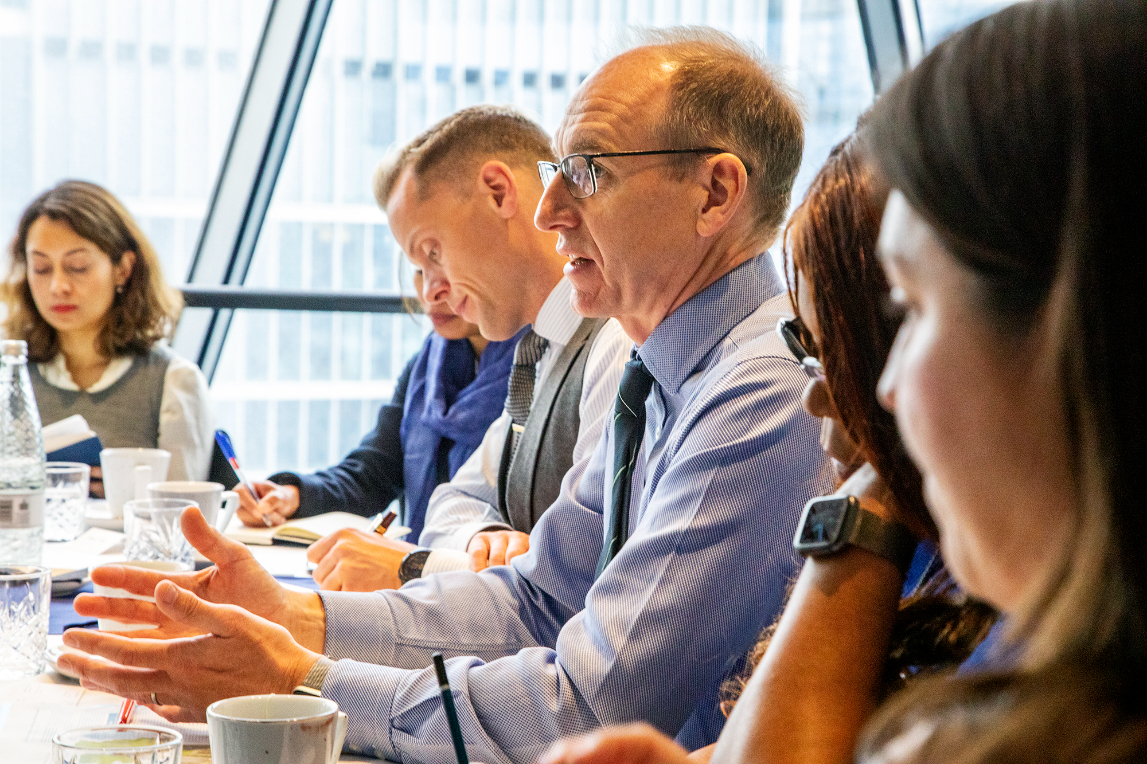
Biodiversity: opportunity, risk & the LGPS
With attendees including those working for the LGPS pools, local government pension funds, local authorities, investment consultancies, advisory firms and asset managers, the discussion looked at both the opportunities and the risks from biodiversity loss for the LGPS.
Chris Dodwell, head of policy and advocacy, Impax Asset Management
Jane Firth, head of responsible investment, Border to Coast
George Graham, director, South Yorkshire Pension Fund
Anastasia Guha, global head of sustainable investment, Redington
Gemma James, senior manager, biodiversity and nature, Chronos Sustainability
Gustave Loriot, responsible investment manager, London CIV
Rachel Perini, head of UK institutional, Jupiter Asset Management
Rhys Petheram, fixed income fund manager and head of environmental solutions, Jupiter Asset Management
Scott Thompson, managing director, Impax Asset Management
Bola Tobun, finance manager (treasury and pensions), London Borough of Enfield
Luke Webster, chief investment officer, Greater London Authority
You really need corporates to understand the location of their assets because this will affect biodiversity risks. It isn’t like carbon, where you have got one tonne that gets emitted in Bangalore or Birmingham and it has the same impact.

Dodwell stressed the significance of the UK government’s use of nature as a theme for COP 26 in Glasgow last year – it was one quarter of prime minister Boris Johnson’s mantra of “coal, cars, cash and trees”. “You can see pathways to get to net zero in a number of sectors, but I think what had been underestimated was the need for nature to be part of the solution. Effectively you don’t get to 1.5 degrees unless you maximise the impact of nature in terms of absorbing carbon, and you effectively stop deforestation.” The potential of nature-based solutions will be a big part of the discussion at COP 15, the UN biodiversity conference, which will hold its in-person sessions in Kunming, China later this year. The conference will look at the implementation of the protocols of the Convention on Biological Diversity (CBD) and seek to create a Global Biodiversity Framework (GBF). One of the key parts of the deal being negotiated is a goal to make 30% of the Earth’s land and seas into protected areas by 2030.
Lack of metrics
Asked whether there needed to be a naturebased equivalent to the Paris 1.5°C target, Dodwell highlighted that the international biodiversity negotiations were currently more focused on the agreement of high-level concepts such as Nature Positive and the GBF than metrics. Nature Positive seeks to halt and reverse nature loss measured from a baseline of 2020, so that by 2030 nature is “visibly and measurably on the path of recovery”. But he added: “I think this lack of metrics is an issue. We are still searching for a proxy for carbon. What is that going to look like? I think it will be a set of indicators, rather than one simple indicator.”
Gustave Loriot, responsible investment manager at London CIV, mentioned the Nationally Determined Contributions (NDCs) by which each country makes commitments to reduce greenhouse gas emissions and adapt to climate change in the context of national priorities, circumstances and capabilities. “I think a lot of investment managers and asset owners setting targets is also the result of governments setting their NDCs and netzero pledges. So are we going to see the same thing for natural capital and biodiversity or will the investment industry leapfrog what governments could do?” he asked. Dodwell mentioned a pledge supported by investors at COP 26 that aimed to end deforestation by 2030. The GBF requires countries to put together action plans that are similar to NDCs, but they lack the detail of the climate pledges agreed in Paris in 2015.
Monitoring, reporting and verification are always going to be issues. It is even more difficult with natural capital/biodiversity compared with climate.

“So I do think there is a chance that corporates and finance could move ahead of governments. And the good thing about that is you then create a policy space for governments to say, ‘actually if we are getting pressure to do stuff from wider stakeholders then this will be a popular thing for us to do. Because at the moment the debate in the Convention on Biological Diversity is still one that I would say was happening ten years ago in climate change.”
Monitoring, reporting and verification
Loriot raised the issue of “conservation-type bonds” being created in developing countries, but added: “Monitoring, reporting and verification are always going to be issues. It is even more difficult with natural capital/ biodiversity compared with climate. We are already having such a struggle ensuring that carbon offsets are actually delivering the offsets that they say they are delivering. Natural capital is that on steroids, really.”
Jane Firth, head of responsible investment at Border to Coast, pointed out that there was a lack of data to enable investors to dig deep into their portfolios and see what the risk is all the way through the supply chain. She said that both the TNFD and Nature Action100 (due to launch later this year as a nature-based version of Climate Action 100+) would help in this endeavour. “It is crucial on issues such as this that investors have a joined-up and collaborative approach. So I am looking forward to what comes out of Nature Action 100 and how we can properly get involved in that,” she said. Border to Coast is a member of the Investors Policy Dialogue on Deforestation (IPDD) initiative, which provides a forum for investors to engage with public agencies and industry associations in selected countries, including Brazil and Indonesia, on the issue of deforestation. Border to Coast also uses Robeco, an international asset manager, to help with engagement on biodiversity.
Government incentives
Bola Tobun, finance manager (treasury and pensions) at the London Borough of Enfield, said that government incentives were needed to help turn around biodiversity loss because “the LGPS is not philanthropic” and returns need to “stack up” to justify an investment. “The government needs to have some sort of incentive policy because at the end of the day each fund has a fiduciary duty and it is very critical and important for us that whatever we are investing in, we are able to give a decent return.”
George Graham, director of South Yorkshire Pension Fund, said he feared that there would be an increasing number of campaigns calling for divestment from companies such as paper manufacturers because of their impact on forestry. He said it was important to be on top of this issue, understanding the nuances and recognising where the risks lie. However, he added: “We certainly haven’t got biodiversity risk on our risk register. I don’t imagine that many, if any, LGPS funds have. That is another interesting debate to work out how big the risk is in the risk register and how do you score it? What do you do to mitigate it?”
Rhys Petheram, fixed income fund manager and head of environmental solutions at Jupiter Asset Management, said there had already been a significant divestment debate over Brazilian beef. A number of European supermarkets had stopped selling Brazilian meat products after suggestions that they contributed to the destruction of the Amazon rainforest. He pointed out the impact this could have on communities in Brazil and that it could lead to farmers cutting their costs through more deforestation.
The government needs to have some sort of incentive policy because at the end of the day each fund has a fiduciary duty and it is very critical and important for us that whatever we are investing in, we are able to give a decent return.

Another fixed-income vehicle involves sustainability-linked bonds (SLBs). These are issued with specific sustainability performance targets (SPTs), which contain key performance indicators, for example, “the percentage of recycled materials used in the manufacturing process” by a specific year. If the SPT is missed the bond is subject to a “coupon step-up” clause, meaning the bond interest increases. SLBs are mainly issued by corporates, but in March 2022 Chile issued the first sovereign SLB. The $2trn bond has two KPIs geared towards reducing carbon emissions and increasing the use of renewable energy.
Chile’s government is the first to link its official NDC commitment on climate change to a bond issuance. “The KPIs link quite nicely into what the issuer is actually doing. It can be a useful way to influence government policy in a way that brings in private capital. So I quite like them from that perspective. I prefer them to green bonds issued by governments because one of the weaknesses of green bonds is that they are fungible – the money doesn’t typically go into a dedicated account. In the case of a government, this means you are funding the general budget, with an intangible accounting link to green spending or subsidies. This makes it more challenging to see the forward-looking impact.”
Sacrifice on returns
Petheram then returned to the issue of the fiduciary duty of those running LGPS funds. He accepted that there can be a sacrifice on returns in some instances, estimated in the green bond market to be about five basis points in aggregate, although this varies across issuers.
However, he added: “Currently, it sits really nicely for issuers because there is a lot of demand and during the course of this year there is going to be incremental demand as funds start to try to report on impact and realise that actually the green bond market could notch up the numbers quickly.” Tobun said that there were other advantages to the fixed-income approach. “Currently, it is a good time for us to go into something like that because a lot of us want to de-risk. We know the equity market is going to fall or reduce one way or another. And going into bonds will be good if you are de-risking.”
Rachel Perini, head of UK institutional at Jupiter Asset Management, offered an important distinction. “It is the difference between ‘impact’ with a capital ‘I’ and ‘impact’ with a lower-case ‘i’. I hear people talk about impact with a lower-case ‘i’ meaning it is about investing in those real-world outcomes but not sacrificing returns. Whereas impact with a capital ‘I’ is more thinking about the impact over the returns – it will completely depend on you as an investor and your objectives.” Luke Webster, chief investment officer at the Greater London Authority (GLA), looks at the market from both sides. Investment is a big part of his role at the GLA but, as one of the project directors for the London Mayor’s Green Finance Programme, he is also contemplating a large green bond issue late this year.
Anybody who issues a green bond is taking on considerable additional cost and effort to achieve certification, develop their framework and green prospectus. So investors have to reward that.

“So we are definitely hoping that will achieve a pricing advantage versus our general corporate debt. Anybody who issues a green bond is taking on considerable additional cost and effort to achieve certification, develop their framework and green prospectus. So investors have to reward that,” he said. “The desirability of these kind of instruments will increase over time and certainly not diminish so it is worth taking a small reduction now to have a more valuable instrument for the long run. That is how I would make the case."
Pressure to adopt TNFD framework
Anastasia Guha, global head of sustainable investment at Redington, said a lot of the pressure in the UK to adopt the TNFD framework is coming from pensions minister Guy Opperman. In a joint article with minister for the Pacific Lord Goldsmith in March 2022, Opperman highlighted the role that deforestation is playing in climate change and said that pension trustees and other investors should be taking this into account when making investment decisions. Guha expected to see an “accelerated process of what we have seen on climate change”, with the TNFD taking a prominent role. “You have started to get all the pieces of the puzzle falling into place.
With the TNFD you have got the scenario analyses from the central banks. And the risk framework is probably going to come on board faster. The problem is more dispersed than climate change and more local – both of which are hard. We are not going to get trustees to understand every issue on biodiversity, I think.”
Gemma James, senior manager for biodiversity and nature at Chronos Sustainability returned to the issue of engagement through investor initiates such as Nature Action 100 and the IPDD. These, she said offered a “huge opportunity” to change hearts and minds. “You have an opportunity to bring together some of the fixed-income and solutions guys with the listed equities, because there is a role for fixed-income to be engaging with governments and with the companies. The issues on the ground play out exactly the same. It doesn’t matter what asset class you are in, whatever happens on the ground is the same.” With Nature Action 100 in particular, she said, investors will be able to engage with companies, but also make the case to policymakers about the regulatory environment that is required.
“You have an opportunity to bring together some of the fixed-income and solutions guys with the listed equities, because there is a role for fixed-income to be engaging with governments and with the companies.

Alternative funding sources
As the debate drew to a close, Dodwell predicted a priority would be for the TNFD to include some metrics. This, he said, would help with the engagement process. However, the real challenge was that nature-based solutions were unlikely to generate revenue of their own and so an alternative funding source would be necessary. “That could be grant funding coming from developed countries to developing countries or coming from the Multilateral Development Banks to fund projects. Or it could be projects that you are deriving a benefit from because it is creating a credit which can be used for a yet to be created nature-related offsetting framework.”
Some funding is likely to be available at COP15 but not at the required scale. “In comparison with the $100bn referred to in the Paris Agreement or even the trillions that are meant to be mobilised through GFANZ [the Glasgow Financial Alliance for Net Zero], it will be a drop in the ocean.”
The final word went to Petheram, who said he had been encouraged by the discussion, and particularly the emphasis on a wide range of solutions. No longer is the focus solely on equities, he said, and the inter-relationship between climate change and biodiversity loss is becoming better understood. “It’s really encouraging from that perspective, but there are clear challenges in being able to implement policy and investment frameworks that are coming our way over the next few years. We are probably where climate change was seven, eight or nine years ago. But the rate of change is incrementally faster.”




